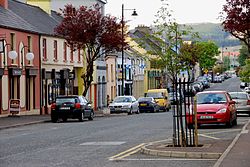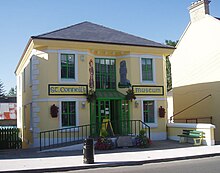Glenties
Glenties
Na Gleannta | |
|---|---|
Town | |
 Main street in Glenties | |
| Coordinates:54°47′51″N8°16′57″W/ 54.7975°N 8.2825°W | |
| Country | Ireland |
| Province | Ulster |
| County | County Donegal |
| Government | |
| •Dáil Éireann | Donegal |
| •EU Parliament | Midlands–North-West |
| Elevation | 78 m (256 ft) |
| Population | 927 |
| Time zone | UTC+0(WET) |
| • Summer (DST) | UTC+1(IST(WEST)) |
| Irish Grid Reference | G818944 |
Glenties(Irish:Na Gleannta,meaning 'theglens')[2]is a town inCounty Donegal,Ireland. It is situated where two glens meet, north-west of theBluestack Mountains,near the confluence of two rivers. Glenties is the largest centre of population in the parish of Iniskeel. Glenties has won theIrish Tidy Towns Competitionfive times in 1958, 1959, 1960, 1962 and 1995. As of the2022 census,the population was 927.[1]
History
[edit]Evidence of early settlement in the area is given by the manydolmens,standing stonesand earthenringfortsdating from theBronze Age.The area became part of the baronies ofBoylagh and Bannaghin 1609, which was granted toScottishundertakersas part of theUlster Plantation.
Glenties was a regular stopping point on the road between the established towns ofBallybofeyandKillybegs,and grew from this in the 17th and 18th centuries. The town was developed as a summer home for theMarquess Conynghamin the 1820s, because of its good hunting and fishing areas. Thecourt houseandmarket housewere built in 1843. TheBank of Irelandbuilding was completed in 1880.[3]
Famine era
[edit]Aworkhousewas built, in 1846 during theGreat Famine,at the site of the current comprehensive school, serving the greaterInniskeelarea. A 40-bed fever hospital was later added to care for the sick and dying.[citation needed]The landlord, the Marquis of Conyngham, decided to halve the population of the town in 1847, faced with the rising costs of the workhouse. Only those who could showtitleto their land as rent payers were allowed to remain. The rest were given an option of going to America on a ship provided or entering the Workhouse in Glenties. Over 40,000 people died or emigrated fromCounty Donegalbetween the years 1841 and 1851.[3]
20th century
[edit]
The railway was completed in 1895 fromBallybofey.In 1903 a local water scheme was established, to be replaced in 1925 by the current Lough Anna supply. In 1932 electricity was first generated locally in the town. Therural electrificationscheme reached the area in the 1950s.
GlentiesRoyal Irish Constabulary(RIC)barrackswas attacked on several occasions, during theWar of Independence,in 1920 and 1921. On 29 June 1921, theIrish Republican Armyambushed a group ofBlack and Tanswho were on their way toArdaraat Kilraine, resulting in the death of a Constable Devine.[citation needed]
TwoNational Armysoldiers were killed at Lacklea in 1922 byIrish Republican Armyforces, during theCivil War.
In January 1944, a BritishRAFSunderland Mark IIIflying boatcrashed in the Croaghs area of theBluestack Mountains,outside of Glenties, killing seven of its 12-man crew.[3]
Brendan Behanspent more than two months with his wife on holiday in Glenties, starting in the third week of May 1960, and staying at the Highlands Hotel. During their stay, on Sunday 24 July, the hotel was raided byGardaíand the hotelier charged with a breach of licensing laws (the raid came more than three hours after closing time).[4]The case was dismissed when it was explained that the event had been taking place in a private room where Behan was doing "some of his literary work".[4]Other events, documented by theDonegal Democrat,included Behan attending anIrish Countrywomen's Associationdance and he and his wife being "guest artistes" at a meeting of theArdaraand Glenties branch ofComhaltas Ceoltóirí Éireann.[4]
Glenties was the first townland in County Donegal to provide cable television to the local area. In 1976 "Glenties Community Piped TV Co-op" was established which brought cable television to Glenties and the surrounding area, enabling viewers to enjoy multi-channel television from Northern Ireland via BBC One, BBC Two, Ulster Television and from 1982 Channel Four along with the national RTE channels.[5]
In April 2006, IRA informerDenis Donaldsonwas shot dead by theReal IRAat a remote cottage near Derryloaghan, 8 km from Glenties.
Bord na Móna
[edit]Bord na Mónabought 1,200 acres (490 ha) ofbogin 1937 to be drained and cut forpeat.By 1943 a railway had been extended fromKilraineacross the Owenea River to the bogs atTullyard.Machine cutting commenced in 1946, utilising German-made cutting machines. The company employed 250 men in peak season and peak production was 22,000 tons in 1965. Operations ceased in the late 1990s and the railways andstockwere lifted in 2006.[3]
Politics
[edit]Glenties is aMunicipal District,which returns six local residents toDonegal County Council.[6]Nationally, Glenties is part of the five-seatDonegal Dáil constituency.
Places of interest
[edit]Glenties is situated at the meeting of two glens, and two rivers; the Owenea and Stranaglough.
St. Connell's church
[edit]One of the most unusual buildings in the area is St Connell's church, which was built in 1974 to replace the old church.[citation needed]The building has a flat roof sloping to the ground at a sharp angle. The original bell from the first church is still used today in the newer church. St. Connell is the patron saint of the parish. Liam McCormack won a European Award for the design of the church in 1974.[citation needed]
Patrick MacGill statue
[edit]A memorial to the 'NavvyPoet',Patrick MacGill,who was born in Glenties, is located on the bridge over the river in the centre of town.
St. Connell's Museum
[edit]
St. Connell's Museum and Heritage Center houses a collection of local history artefacts, including some from the famine era. The museum is named after St. Connell Caol, who founded a monastic settlement onInishkeel Islandin the 6th century. The museum also has a display aboutCardinal Patrick O'Donnell,mementoes from the filming ofDancing at Lughnasa,and a display about theCounty Donegal Railways Joint Committee.It also has a reading room which contains local historic records.[citation needed]
Sport
[edit]The localGaelic gamesclub –Naomh Conaill– fields teams at all age levels, playing football predominantly.
In popular culture
[edit]Glenties was a model forBrian Friel's fictional village ofBallybeg,where several of his works were set. His playDancing at Lughnasa,for example, was set in Ballybeg.
Transport
[edit]Fintown Railway | ||||||||||||||||||||||||||||||||||||||||||||||||||||||||
|---|---|---|---|---|---|---|---|---|---|---|---|---|---|---|---|---|---|---|---|---|---|---|---|---|---|---|---|---|---|---|---|---|---|---|---|---|---|---|---|---|---|---|---|---|---|---|---|---|---|---|---|---|---|---|---|---|
| ||||||||||||||||||||||||||||||||||||||||||||||||||||||||
Glenties railway stationwas on a branch line of theCounty Donegal Railways Joint Committee,a narrow-gauge railway system. The Glenties branch was the first part of the County Donegal Railways to be closed; the railway station (and the branch line) opened on 3 June 1895 and finally closed on 15 December 1947.[7]
Bus transport is currently provided byBus Éireann,operated by McGeehan's Coaches, which provides services toLetterkenny,Ballybofey,Dungloe,Ardara,KillybegsandDonegal Town.[8]
Tidy Towns
[edit]Glenties was the national winner ofIreland's Tidy Townscompetition in 1958, 1959, 1960, 1962, and 1995. TheRadharcdocumentary series included a short film following Glenties' third time winning the competition.[citation needed]
In September 1962 a special ceremony was held to commemorate the town winning the competition. Then Minister for Transport and EnergyErskine Childersunveiled a plaque and the occasion was filmed by RTÉ.[9][10]
Glenties also received gold medals, in the Tidy Towns competition, in 2004, 2005, and 2006 and a silver medal winner in 2003. It also received a silver medal in the EuropeanEntente Floralecompetition held inGyőr,Hungary in 2005.[citation needed]
People
[edit]- Patrick O'Donnell(1856–1927) –Primate of All Ireland
- Thomas F. Breslin(1885–1942) – colonel, victim of theBataan Death March
- Patrick MacGill(1889–1963) – the "Navvy Poet"
- Paddy O'Daire(1905–1981) – soldier and activist
- FatherJames McDyer(1910–1987) – Catholic priest and social campaigner
- Brian Friel(1929–2015) – playwright
- Tom Gildea(born 1939) – politician
- Enda Bonner(born 1949) – politician, Gaelic football
- Jim McGuinness(born 1972) – manager of the seniorDonegal county football team
- Máire O'Neill(born 1978) – engineer and inventor
References
[edit]- ^ab"Census Mapping - Towns: Glenties - Population Snapshot".visual.cso.ie.Central Statistics Office (Ireland).Retrieved29 June2024.
- ^"Na Gleannta/Glenties".Placenames Database of Ireland.Government of Ireland – Department of Arts, Heritage and the GaeltachtandDublin City University.Archivedfrom the original on 5 April 2016.Retrieved5 June2018.
- ^abcdBriody, Liam (1986).Glenties and Inniskeel – A Study of Glenties Town and Inniskeel Parish.Donegal Democrat Ltd.
- ^abcMacSuibhne, Breandan (2 August 2020)."The summer Brendan Behan staycationed in Donegal".Sunday Independent.Archivedfrom the original on 6 August 2020.Retrieved2 August2020.
- ^"Ceisteanna—Questions. Oral Answers. – Cable Television. – Dáil Éireann (24th Dáil) – Tuesday, 17 Jun 1986 – Houses of the Oireachtas".Archivedfrom the original on 16 July 2019.Retrieved19 July2019.
- ^"Donegal County Council".donegalcoco.ie.Archivedfrom the original on 22 March 2016.Retrieved14 April2016.
- ^"Glenties station"(PDF).Railscot – Irish Railways.Archived(PDF)from the original on 26 June 2015.Retrieved14 October2007.
- ^"McGeehan's Coaches".Timetables and Contact details.Archivedfrom the original on 22 March 2009.Retrieved24 March2009.
- ^"Tidy Town Glenties".RTÉ Archives.Archivedfrom the original on 27 October 2023.Retrieved27 October2023.
- ^Admin, IFI Archive Player (24 August 2016),Glenties Tidy Towns – Radharc,archivedfrom the original on 27 October 2023,retrieved27 October2023
External links
[edit]- Glenties.ieArchived24 September 2004 at theWayback Machine
- County Donegal website's Glenties entry


